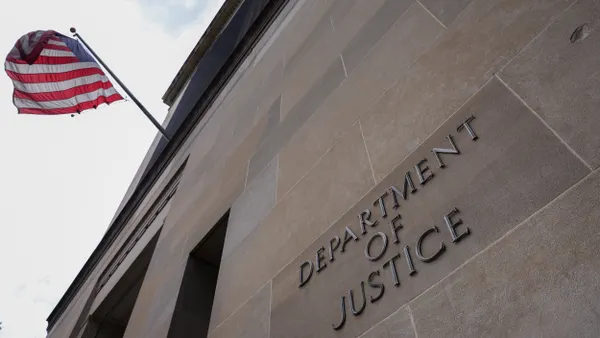Dive Brief:
- Homicides and aggravated assaults increased 37% and 35%, respectively, in late May and June across a number of U.S. cities, according to a recent report by The Council on Criminal Justice.
- The study evaluated crime rates for 11 different offenses across 27 U.S. cities during the coronavirus (COVID-19) pandemic and nationwide demonstrations against police violence.
- Robbery rates have also spiked 27% from March through June, while residential burglaries, larcenies and drug offenses have fallen, likely due to quarantines, business closures and fewer police and street activity. Commercial burglaries, however, increased 200% during one week in late May/early June before returning to earlier levels, likely due to property damage at the onset of protests against police violence.
Dive Insight:
The pandemic must be subdued to halt the increase in violence, the Council writes. Additionally, this violence is likely to continue without effective police reforms and effective violence-reduction strategies, according to the report.
To better understand the current rise in crimes, city officials could look back to 2014 and 2015 when police brutality led to protests in Ferguson, MO, Baltimore, Chicago and other cities. During that time, cities saw a similar rise in homicides and violence, which remained elevated in some places for many months, said Richard Rosenfeld, report author and Professor Emeritus of Criminology and Criminal Justice at the University of Missouri-St. Louis.
"That comparison is useful to figure out what may be going on now," he said.
Experts have connected the rise in violence during that period to two potential causes. First, a number of police withdrew from their normal patrol assignments due to concerns over increased legal liability, or so-called "depolicing." The second explanation argues that communities of color, where violent crime tends to be highest and where instances of police brutality can be concentrated, drew back even further from the police and became less likely to report crimes, according to the report.
Following that period of heightened violence, cities "by and large" didn’t implement much effective reform to curb the violence, with the possible exception of Chicago, according to Rosenfeld.
Chicago engaged in what appeared to be fairly effective reform by concentrating more resources in high-violence neighborhoods, Rosenfeld said, which the city administration and police department credited with a drop in crime from 2017-2019.
And while those events are useful to help make sense of the rise in crime occurring today, it’s also critical to remember one important exception to that comparison: COVID-19.
"It’s important to keep in-mind the impact of COVID on the police," he said.
Many officers have been taken off the job due to COVID, and officers who remain on the job are not able to perform at the level they once could due to constraints from the virus, impacting their ability to prevent and investigate crimes, Rosenfeld said.
Cities are now wrestling with both the pandemic and national unrest over police brutality. But unlike five years ago, some cities appear to be implementing various reforms and responding to some protestor demands.
Minneapolis, for example, has moved to completely dismantle its police department, while other cities like New York, Burlington, VT, Charleston, WV and Las Vegas have slashed funding to their police budgets (though many of those cities also were forced to cut their overall budgets due to financial strains from the pandemic). Meanwhile, over 80 cities and counties have declared racism to be a public health crisis.
City and state officials are in tough positions right now, but good faith efforts on police reform at the state and municipal levels can help limit the period of elevated violence and address some of the protestor demands, Rosenfeld said.
Experimentation with those reforms will be key, he said, noting city officials and police departments should show a firm public commitment with highly publicized experimentation, signaling to much of the general public that officials are taking the calls for reform seriously.












